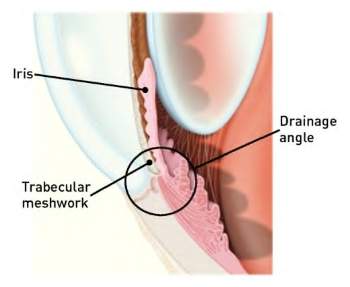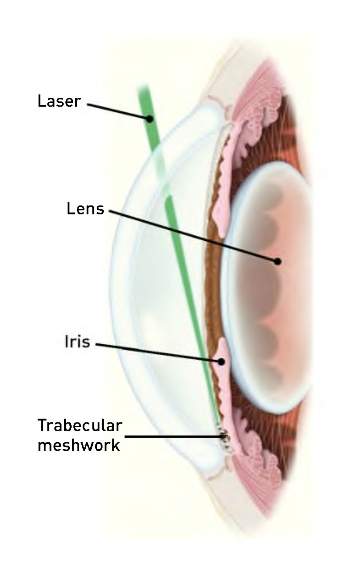Selective Laser Trabeculoplasty (SLT) for Glaucoma
A Closer Look
What is Glaucoma?

Glaucoma is a disease of the optic nerve — the part of the eye that carries the images we see to the brain. The optic nerve is made up of many nerve fibers, like an electric cable containing numerous wires. When damage to optic nerve fibers occurs, blind spots develop. These blind spots usually go undetected until the optic nerve is significantly damaged. If the entire optic nerve is destroyed, blindness results.
The most common form of glaucoma is chronic open angle glaucoma, in this condition, a part of the eye called the drainage angle becomes less efficient at draining microscopic amounts of fluid from the eye over time, allowing pressure within the eye to gradually increase. The increased pressure slowly and painlessly destroys the nerve fibers in the optic nerve.
Eyes have different abilities to withstand eye pressure. Some people can even develop glaucoma damage at normal pressures. When someone is at high risk for further nerve damage, treatment to lower eye pressure is necessary to prevent further vision loss. Early detection and treatment by your ophthalmologist (Eye M.D.) are the keys to preventing blindness from glaucoma.
How Can Selective Laser Trabeculoplasty Help Treat Open-Angle Glaucoma?
Selective laser trabeculoplasty (SLT) uses a neodymium :YAG laser to focus light energy on the internal drainage channel of the eye. SLT targets the pigmented (melanin-containing) cells in the trabecular meshwork using a very short application of light. Because SLT uses a low amount of energy, the surrounding tissue is not damaged. The treatment allows the drain to work more efficiently, successfully lowering eye pressure more than 80 percent of the time.
After SLT, your eye pressure may increase over time. By five years, up to half of the people treated with SLT experience a rise in eye pressure. Your doctor will need to continue to monitor your eye pressure and can repeat the SLT treatment if needed.
Who is a Candidate for SLT?

Laser surgery can reduce the amount of medication you may need and is often recommended when you have trouble inserting eyedrops or are not using eyedrops on a regular basis. SLT can also be used in addition to taking medicines or as a first line of treatment.
How is SLT Done?
The procedure is done in the ophthalmologist's office and usually takes less than 10 minutes. First, anesthetic drugs are used to numb the eye. Additional drops are given to control eye pressure. While you are seated at the examining microscope, the laser energy is then focused through a lens to treat the drainage channel. You will experience a flash of light with each laser application. There is rarely discomfort with this treatment.
After treatment your eye pressure will be monitored. Your doctor may want to monitor your eye pressure for one to two hours after the procedure. Very rarely, eye pressure can rise, requiring additional treatment. Anti-inflammatory medications are often prescribed for several days after the procedure.
Your vision will be blurry immediately after treatment but should clear within hours. Most people can return to their normal activities the day after laser surgery.
It will take several weeks for the laser treatment to take full effect. Your doctor will want to check your eye pressure one to two months after the procedure. If your eye pressure is not lower at the first visit, some additional effect can be gained up to three months after treatment. If lower eye pressure is needed, your Eye M.D. will help you decide whether additional laser treatment, medication or surgery is required.
What are the Risks of SLT?
As with any surgery, there are some risks of complications with SLT. Possible complications include:
- Failure to adequately lower the eye pressure
- Increased pressure in the eye, possibly requiring medications or surgery to lower it
- Inflammation in the eye causing pain, redness or blurred vision
There are always risks associated with medications and surgery. Flowever, the risks should be balanced against the greater risk of leaving glaucoma untreated and losing your vision.
If you have any questions about SLT for open-angle glaucoma, you should discuss them with your Eye M.D.




